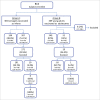Persistence of immunity 18-19 years after vaccination against hepatitis B in 2 cohorts of vaccinees primed as infants or as adolescents in Italy
- PMID: 28272974
- PMCID: PMC5443392
- DOI: 10.1080/21645515.2017.1264795
Persistence of immunity 18-19 years after vaccination against hepatitis B in 2 cohorts of vaccinees primed as infants or as adolescents in Italy
Abstract
This study was aimed at assessing the anti-HBs persistence and immune memory 18-19 y after vaccination against hepatitis B in healthy individuals primed as infants or adolescents. We enrolled 405 teenagers (Group A) vaccinated as infants, and 409 young adults (Group B) vaccinated as adolescents. All vaccinees were tested for anti-HBs and anti-HBc antibodies; those found anti-HBc positive were further tested for HBsAg and HBV DNA. Eight individuals belonging to Group B were positive for anti-HBc alone, and were excluded from analysis. Individuals with anti-HBs concentration ≥ 10 mIU/ml were considered protected while those with anti-HBs concentration <10 mIU/ml were offered a booster dose and re-tested 2 weeks later. Overall, 67.9% individuals showed anti-HBs concentrations ≥ 10 mIU/ml (48.9% in Group A vs 87.0% in Group B, p < 0.001). The antibody geometric mean concentration (GMC) was higher in Group B than in Group A (102.5 mIU/ml vs 6.9 mIU/ml; p < 0.001). When boosted, 94.2% of vaccinees with anti-HBs <10 mIU/ml belonging to Group A and 94.7% to Group B showed an anamnestic response. Post-booster GMCs were similar in both groups (477.9 mIU/ml for Group A vs 710.0 mIU/ml for Group B, p = n.s.). Strong immunological memory persists for at least 18-19 y after immunization of infants or adolescents with a primary course of vaccination. Thus, booster doses are not needed at this time, but additional follow up is required to assess the long-life longevity of protection.
Keywords: HBV; hepatitis B; immune memory; long-term immunity; vaccination.
References
-
- World Health Organization (WHO) Available from http://www.who.int/mediacentre/factsheets/fs204/en/ (last access March7, 2017).
-
- Zanetti AR, Tanzi E, L Romanò, Grappasonni I. Vaccination against hepatitis B: the Italian strategy. Vaccine 1993; 11:521-4; PMID:8488702; http://dx.doi.org/10.1016/0264-410X(93)90222-J - DOI - PubMed
-
- Ministero della Salute Available from http://www.salute.gov.it/imgs/C_17_tavole_20_allegati_iitemAllegati_0_fi... (last access March7, 2017).
-
- Assad S, Francis A. Over a decade of experience with a yeast recombinant hepatitis B vaccine. Vaccine 1999; 18:57-67; PMID:10501235; http://dx.doi.org/10.1016/S0264-410X(99)00179-6 - DOI - PubMed
-
- Venters C, Graham W, Cassidy W. Recombivax-HB: perspectives past, present and future. Expert Rev Vaccines 2004; 3:119-29; PMID:15056038; http://dx.doi.org/10.1586/14760584.3.2.119 - DOI - PubMed
Publication types
MeSH terms
Substances
LinkOut - more resources
Full Text Sources
Other Literature Sources
Medical
Miscellaneous

